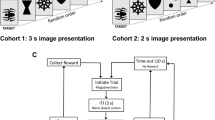Abstract
Methadone addicts and non-addict controls were tested before and after receiving up to 10 mg of methadone on simple visual reaction time tests and on a vigilance type visual attention test. Addicts were faster than controls on pre-drug testing, although there were no pre-drug differences between groups on the attention task. Addicts maintained faster reaction times than controls even when money was offered as an incentive for speed. Additional methadone did not affect addict performance on any of the tasks. Methadone slowed control reaction times in a doserelated fashion. No significant attention decrements were seen after methadone in controls. Visual reaction time differences between addicts and controls cannot be attributed to group differences in motivation or ability to attend. Slowing of reaction time with acute dose of methadone in controls cannot be attributed to the effect of the drug on attention. An hypothesized drug-induced decrease in visual sensitivity with acute dose in controls and a drug-induced increase in visual sensitivity with chronic dose in addicts can account for the presented data.
Similar content being viewed by others
References
Armor, D. J., Couch, A. S.: Data-Text primer: An introduction to computerized social data analysis. New York: Free Press 1972
Dole, V. P., Nyswander, M. E.: Medical treatment for diacetylmorphine (heroin) addiction. A clinical trial with methadone hydrochloride. J. Amer. Med. Ass. 193, 646–650 (1965)
Duffy, E.: Activation and behavior. New York-London: Wiley 1962
Evans, W. O., Jewett, A.: The effect of some centrally acting drugs on disjunctive reaction time. Psychopharmacologia (Berl.) 3, 124–127 (1962)
Foldes, F., Swerdlow, M., Siker, E.: Narcotics and narcotic antagonists. Springfield, Ill.: Ch. C. Thomas 1964
Frankenhaeuser, M., Post, B.: Objective and subjective performance as influenced by drug-induced variations in activation level. Univ. Stockholm Psychol. Lab. Rep 184, 1–18 (1965)
Goodman, L., Gilman, A.: The pharmacological basis of therapeutics, 4th ed. New York: MacMillan 1970
Gordon, N. B.: Reaction times of methadone treated ex-heroin addicts. Psychopharmacologia (Berl.) 16, 337–344 (1970)
Lorens, S., Mitchell, C.: Influence of morphine on lateral hypothalamic self-stimulation in the rat. Psychopharmacologia (Berl.) 32, 271–277 (1973)
Mackworth, J.: The effect of amphetamine on the detectability of signals in a vigilance task. Canad. J. Psychol. 19, 104–110 (1965)
Mirsky, A., Kornetsky C.: On the dissimilar effects of drugs on the digit symbol substitution and continuous performance tests. Psychopharmacologia (Berl.) 5, 161–177 (1964)
Neal, G. L., Pearson, R. G.: Comparative effects of age, sex and drugs upon two tasks of auditory vigilance. Percept. Motor Skills 23, 967–975 (1966)
Pribram, K. H., McGuinness, D.: Arousal, activation, and efforts in the control of attention Psychol. Rev. 82, 116–149 (1975)
Rosvold, H., Mirsky, A., Sarason, I., Bransome, E., Jr., Beck, L.: A continuous performance test of brain damage. J. cons. Psychol. 20, 343–350 (1956)
Schottenfeld, S., Rothenberg, S.: An automated laboratory control system: Collection and analysis of behavioral and electrophysiological data. Computer Progr Biomed. 5, 296–306 (1976)
Valdman, A. V., Arushanyan, E. B.: The influence of analgetic drugs on segmental and suprasegmental inhibition. In: Pharmacology and physiology of the reticular formation, Progress in brain research. Vol. 20, A. V. Valdman, ed., pp. 223–242. Amsterdam: Elsevier 1967
Volavka, J., Zaks, A., Roubicek, J., Fink, M.: Electrographic effects of diacetylmorphine (heroin) and naloxone in man. Neuropharmacology 9, 587–593 (1970)
Wikler, A.: Dynamics of drug dependence: Implications of a conditioning theory for research and treatment. In: Opiate addictions: origins and treatment, S. Fisher and A. M. Freedman, eds., pp. 7–21. Washington, D. C.: Winston 1973
Woodworth, R., Schlossberg, H.: Experimental psychology. New York: Holt, Rinehart and Winston 1954
Author information
Authors and Affiliations
Rights and permissions
About this article
Cite this article
Rothenberg, S., Schottenfeld, S., Meyer, R.E. et al. Performance differences between addicts and non-addicts. Psychopharmacology 52, 299–306 (1977). https://doi.org/10.1007/BF00426715
Received:
Accepted:
Issue Date:
DOI: https://doi.org/10.1007/BF00426715




